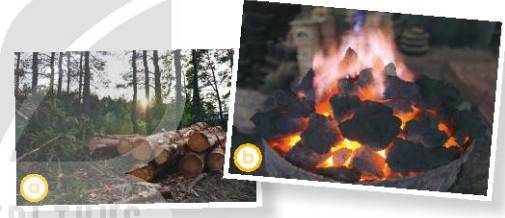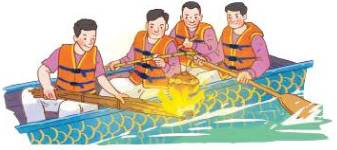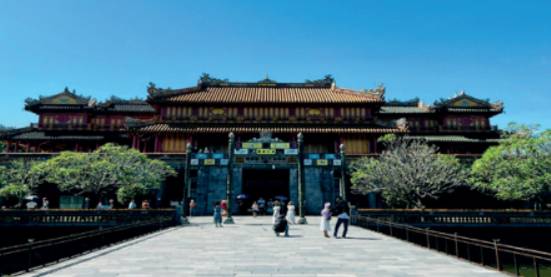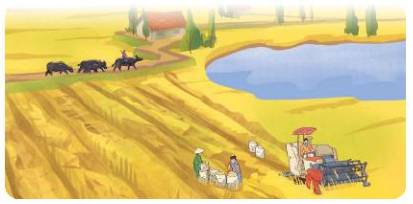Work in pairs. Label the following pictures. Do you often see them in Viet Nam?

Work in pairs. Look at the pictures and discuss the environmental problems you see.

Picture A: Deforestation is a significant environmental issue that occurs when forests are cut down for various reasons. This can result in a loss of plant and animal species, soil erosion, and climate change. Deforestation can negatively impact human communities that rely on forests for their livelihoods. It is important to take action to prevent deforestation and protect our forests for future generations.
Picture B: CO2 emissions are a significant environmental problem that occurs when large amounts of carbon dioxide are released into the atmosphere from human activities. This contributes to the greenhouse effect and global warming, which can have serious consequences such as rising sea levels and more extreme weather events.
Picture A: deforestation
Picture B: air pollution
Work in pairs. Look at the pictures and answer the following questions.

1. What are the men doing?
2. When do you think this event occur?
1. Farmers compete cooking rice on boat.
2. I think it’s occur in the Lunar New Years.
SPEAKING Work in pairs. Discuss the questions.
1. Have you ever visited any castles or palaces in Viet Nam? Which are the most famous ones? Why?
2. Do you recognise the palace in the photo? What do you know about it?

1. I haven’ visited any castles or palaces in VietNam before. However, I know some of the most famous ones such as Hue Imperial Citadel, the Thang Long Imperial Citadel, and the Ho Dynasty Citadel. These historical sites are significant because they showcase the country's rich history and cultural heritage.
(Tôi chưa từng đến thăm bất kỳ lâu đài hay cung điện nào ở Việt Nam trước đây. Tuy nhiên, tôi biết một số địa điểm nổi tiếng nhất như Cố đô Huế, Hoàng thành Thăng Long và Thành nhà Hồ. Những di tích lịch sử này rất có ý nghĩa vì chúng thể hiện di sản văn hóa và lịch sử phong phú của đất nước.)
2. I haven’t seen this palace before, but I guess it is the Hue Imperial Citadel.
(Tôi chưa nhìn thấy cung điện này bao giờ, nhưng tôi đoán đó là Hoàng thành Huế.)
Work in pairs. Look at the pictures and discuss the questions below.
1. Can you see in the pictures ?
2. What do you think the objects are made of?
3. Can you guess what hobby it is ?

1. What can you see in the pictures? ( Bạn thấy gì trong bức hình?)
- A teddy bear, a flower, a bird and flowers.
(Một chú gấu bông, một bông hoa, một con chim và nhiều hoa.)
2. What do you think the objects are made of?(Bạn nghĩ những cái này làm bằng gì?)
- They are made of eggshells.
(Chúng được làm từ vỏ trứng)
3. Can you guess what hobby it is?(Bạn có thể đoán sở thích đó là gì không?)
- The hobby is carving eggshells.
(Đó là sở thích khắc vỏ trứng.)
1. I can see three eggs about teddy bear, flower and bird.
2. They are made of eggshells.
3. It's carving eggshells.
Work in groups. Discuss the following questions.
Are there similar projects in Viet Nam? Do you think the ideas in 1 can be applied in Viet Nam?
There have been efforts in Vietnam to protect and restore ecosystems, such as the Green Annamites Project, which aims to protect the forest ecosystem and biodiversity in the Annamites mountain range. In addition, there are initiatives to restore mangrove forests in the Mekong Delta and protect coral reefs in Nha Trang Bay.
Regarding the applicability of the ideas in the text to Vietnam, it depends on the specific context and conditions in Vietnam. The Great Green Wall project, for example, is focused on restoring degraded land in Africa, which may not be directly applicable to Vietnam. However, the idea of ecosystem restoration and protection is relevant to any country, and the principles and strategies used in these projects could be adapted and applied to Vietnam's unique ecological challenges. For example, efforts to protect and restore marine ecosystems like the Belize Barrier Reef could be relevant to Vietnam's extensive coastal areas and rich marine biodiversity. Overall, it would require careful consideration and adaptation to make these ideas applicable to Vietnam.
Tạm dịch:
Việt Nam đã có những nỗ lực bảo vệ và phục hồi các hệ sinh thái, chẳng hạn như Dự án Trường Sơn Xanh nhằm bảo vệ hệ sinh thái rừng và đa dạng sinh học ở dãy Trường Sơn. Ngoài ra, còn có các sáng kiến khôi phục rừng ngập mặn ở ĐBSCL và bảo vệ rạn san hô ở vịnh Nha Trang.
Về khả năng áp dụng các ý trong văn bản vào Việt Nam thì tùy thuộc vào bối cảnh và điều kiện cụ thể ở Việt Nam. Ví dụ, dự án Bức tường xanh vĩ đại tập trung vào việc khôi phục đất bị suy thoái ở Châu Phi, điều này có thể không áp dụng trực tiếp cho Việt Nam. Tuy nhiên, ý tưởng phục hồi và bảo vệ hệ sinh thái phù hợp với bất kỳ quốc gia nào, và các nguyên tắc cũng như chiến lược được sử dụng trong các dự án này có thể được điều chỉnh và áp dụng cho các thách thức sinh thái đặc thù của Việt Nam. Ví dụ, những nỗ lực bảo vệ và phục hồi các hệ sinh thái biển như Rạn san hô Chắn bờ Belize có thể phù hợp với các vùng ven biển rộng lớn và đa dạng sinh học biển phong phú của Việt Nam. Nhìn chung, cần phải xem xét và điều chỉnh cẩn thận để những ý tưởng này có thể áp dụng cho Việt Nam.
Work in groups. Discuss the following questions.
Are the methods of preserving heritage in the text used in Viet Nam? Which one do you think works best in Viet Nam?
Vietnam has several methods of preserving heritage. One of the most common methods is through government funding. The government invests money in preserving heritage sites and objects, and it has been successful in many cases. Another way is through public-private partnerships, where companies provide funding for heritage preservation in exchange for advertising or other benefits.
Vietnam has also used UNESCO funding for the preservation of its cultural heritage. Additionally, the country has implemented strict heritage laws to protect its heritage sites and objects. For example, in 2016, Vietnam passed a law on cultural heritage, which regulates the protection, preservation, and promotion of the country's heritage.
As for which method works best in Vietnam, it depends on the specific context and situation. Each method has its advantages and disadvantages, and a combination of different methods may be the most effective way to preserve heritage in Vietnam.
Work in pairs. Look at the pictures and discuss the questions below.
1. What can you see in the pictures ?
2. What do you think the objects are made of ?
3. Can you guess what hobby it is ?
3. Can you guess what hobby it is?
1. There are eggshell
2. They are made of eggshell
3. Yes I can
bài này ms hok xong nek
mà s ng ta có thể khắc được hay ghê lun á
SPEAKING Work in pairs. Discuss these questions.
1. Which ethnic groups are you in contact with most often? What is most special about them?
2. How are weddings held in your family? What customs do you find the most meaningful?
1.
A: Which ethnic groups are you in contact with most often?
(Những nhóm dân tộc nào bạn tiếp xúc thường xuyên nhất?)
B: The ethnic group I am in contact with most often is Kinh because I was born in city and most of them live here, too.
(Nhóm dân tộc mà tôi tiếp xúc thường xuyên nhất là người Kinh vì tôi sinh ra ở thành phố và hầu hết họ cũng sống ở đây.)
A: Can you tell me what is most special about them?
(Bạn có thể cho tôi biết điều gì đặc biệt nhất về họ không?)
B: The Kinh uses the official language of Vietnam, Vietnamese, as the main language. In Vietnamese society, the Kinh have played a vital part in Vietnamese culture and tradition as well as developing the economy.
(Người Kinh sử dụng ngôn ngữ chính thức của Việt Nam là tiếng Việt làm ngôn ngữ chính. Trong xã hội Việt Nam, người Kinh đã đóng một vai trò quan trọng trong văn hóa và truyền thống Việt Nam cũng như phát triển nền kinh tế.)
2.
A: How are weddings held in your family?
(Đám cưới được tổ chức trong gia đình bạn như thế nào?)
B: The groom’s family and the bride’s family will meet each other to choose the best day for them to celebrate their wedding party. On the wedding day, the groom’s family and relatives go to the bride’s house bringing a lot of gifts wrapped in red papers. Ladies and women are all dressed in Ao Dai. Men could be in their suits or men traditional Ao Dai. The couple should pray before the altar ask their ancestors for permission for their marriage, then express their gratitude to both groom and bride’s parents for raising and protecting them.
(Nhà trai và nhà gái sẽ gặp nhau để chọn ngày tốt nhất để tổ chức tiệc cưới. Trong ngày cưới, nhà trai và họ hàng sang nhà gái mang theo rất nhiều lễ vật được gói trong giấy đỏ. Các bà các cô xúng xính áo dài. Nam giới có thể mặc vest hoặc áo dài nam truyền thống. Trước bàn thờ, đôi uyên ương nên khấn trước bàn thờ xin phép tổ tiên, sau đó bày tỏ lòng biết ơn đối với cha mẹ cô dâu và chú rể đã nuôi nấng, che chở.)
A: What customs do you find the most meaningful?
(Phong tục nào bạn thấy ý nghĩa nhất?)
B: I like the moment when they bow their heads to each other to show their gratitude and respect toward their soon-to-be husband or wife. I also like the moment when their parents take turns to share their experience and give blessings. For me, it’s extremely meaningful.
(Tôi thích khoảnh khắc họ cúi đầu chào nhau để bày tỏ lòng biết ơn và sự kính trọng đối với người chồng người vợ sắp cưới của mình. Tôi cũng thích khoảnh khắc khi cha mẹ của họ thay phiên nhau chia sẻ kinh nghiệm của họ và ban phước lành. Đối với tôi, nó vô cùng ý nghĩa.)
Work in pairs. Discuss the following questions.
1. Where do you most often read the news?
2. What is your favourite news section: Politics, Education, Sports or Culture?
1. I often read news on social media platforms, news apps, or websites.
(Tôi thường đọc tin tức trên các nền tảng mạng xã hội, ứng dụng tin tức hoặc trang web.)
2. My favourite news section is Culture.
(Phần tin tức yêu thích của tôi là Văn hóa.)
Work in pairs. Look at the picture and discuss the following questions.

1. What can you see in it?
2. Which of the following adjectives describe the picture?

1. In the picture, I can see a peaceful village with a vast field.
2. peaceful ; vast ; picturesque
Dịch:
peaceful (adj): yên bình
vast (adj): rộng lớn
crowded (adj): đông đúc
picturesque (adj): đẹp như tranh
noisy (adj): ồn ào